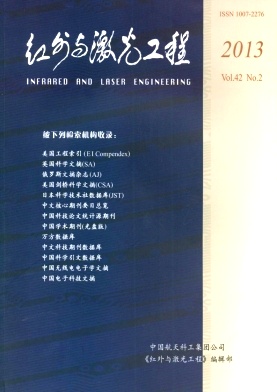|
[1]
|
Bai Lianfa, Zhang Yi, Gu Guohua, et al. Analysis and fusion methods on low light level image and ultra-violet image[J]. Infrared and Laser Engineering, 2007, 36(1): 113-117. (in Chinese) |
|
[2]
|
|
|
[3]
|
Yan Changshan. Study and discussion on some familiar problem of Low-Light-Level image intensifier[J]. Yunguangjishu, 2001, 33(6): 18-20. (in Chinese) |
|
[4]
|
柏连发, 张毅, 顾国华, 等. 微光图像和紫外图像分析与融合方法研究[J]. 红外与激光工程, 2007, 36(1): 113-117. |
|
[5]
|
|
|
[6]
|
Xiang Shiming, Ni Guoqiang. The Principle of Photoelectronic Imaging Devices[M]. Beijing: National Defense Industry Press, 2006. (in Chinese) |
|
[7]
|
|
|
[8]
|
Qian Yunsheng, Chang Benkang, Qiu Yafeng, et al. Measurement of luminance gain and equivalent background input LLL image intensifiers[J]. Vacuum Electronics, 2004(2): 34-37. (in Chinese) |
|
[9]
|
Shi Jifang, Wang Shengyun, Sun Yunan, et al. Third generation of image intensifier brightness gain measurement device[J]. Journal of Applied Optics, 2011, 32(2): 300-302. (in Chinese) |
|
[10]
|
闫常善. 微光像增强器几个常见问题的研究与探讨[J]. 云光技术, 2001, 33(6): 18-20. |
|
[11]
|
Qiu Yafeng, Qian Yunsheng, Chang Benkang. Research and development of luminance gain and equivalent background input test set for LLL image intensifier[J]. Infrared Technology, 2003, 25(5): 76-79. (in Chinese) |
|
[12]
|
|
|
[13]
|
|
|
[14]
|
Gao Yue, Wang Zhongchun, Gao Zhiyun. Test instrument for brightness gain and background of image tube[J]. Journal of Applied Optics, 2003, 24(5): 14-15. (in Chinese) |
|
[15]
|
Li Jingsheng, Chen Wei, He Yingping, et al. GJB598 specification for generation Ⅲ image intensin assembly[S]. Beijing: China ordnance Industria standardization Research Institute, 2007: 8-11.(in Chinese) |
|
[16]
|
向世明, 倪国强. 光电子成像器件原理[M].北京:国防工业出版社, 2006. |
|
[17]
|
|
|
[18]
|
Yu Shengyun, Qian Jing, Yong Chaoliang, et al. Temperature control system and performance test method for new infrared radiant target[J]. Infrared and Laser Engineering, 2011, 40(2): 199-202. (in Chinese) |
|
[19]
|
Fang Ruzhang, Liu Yufeng. Optoelectronic Devices[M]. Beijing: National Defence Industry Press, 1988. (in Chinese) |
|
[20]
|
|
|
[21]
|
钱芸生, 常本康, 邱亚峰, 等. 微光像增强器亮度增益和等效背景照度测试技术[J]. 真空电子技术, 2004(2): 34-37. |
|
[22]
|
Zhou Xiaoli, Liu Muqing. Control the stability of infrared radiation source[J]. Lamps Lighting, 2004(4): 4-8. (in Chinese) |
|
[23]
|
Zou Yisong, Liu Yufeng, Bai Tingzhu. Principles of Optical Imaging[M]. Beijing: Beijing Institute of Technology Press, 1997. (in Chinese) |
|
[24]
|
|
|
[25]
|
|
|
[26]
|
史继芳, 王生云, 孙宇楠, 等. 三代微光像增强器亮度增益测量装置[J]. 应用光学, 2011, 32(2): 300-302. |
|
[27]
|
|
|
[28]
|
|
|
[29]
|
邱亚峰, 钱芸生, 常本康. 像增强器亮度增益和等效背景照度测试仪的研制[J]. 红外技术, 2003, 25(5): 76-79. |
|
[30]
|
|
|
[31]
|
|
|
[32]
|
高岳, 王仲春, 高稚允. 像管亮度增益与背景测试仪[J]. 应用光学, 2003, 24(5):14-15. |
|
[33]
|
|
|
[34]
|
|
|
[35]
|
|
|
[36]
|
于胜云, 钱婧, 雍朝良, 等. 红外辐射源标温控及性能测试方法[J]. 红外与激光工程, 2011, 40(2): 199-202. |
|
[37]
|
|
|
[38]
|
|
|
[39]
|
方如章, 刘玉凤. 光电器件[M]. 北京: 国防工业出版社. 1988. |
|
[40]
|
|
|
[41]
|
|
|
[42]
|
周小丽, 刘木清. 近红外光源的稳定性控制[J]. 光源与照明, 2004(4): 4-8. |
|
[43]
|
|
|
[44]
|
|
|
[45]
|
邹异松, 刘玉凤, 白廷柱. 光电成像原理[M]. 北京: 北京理工大学出版社, 1997. |









 DownLoad:
DownLoad: